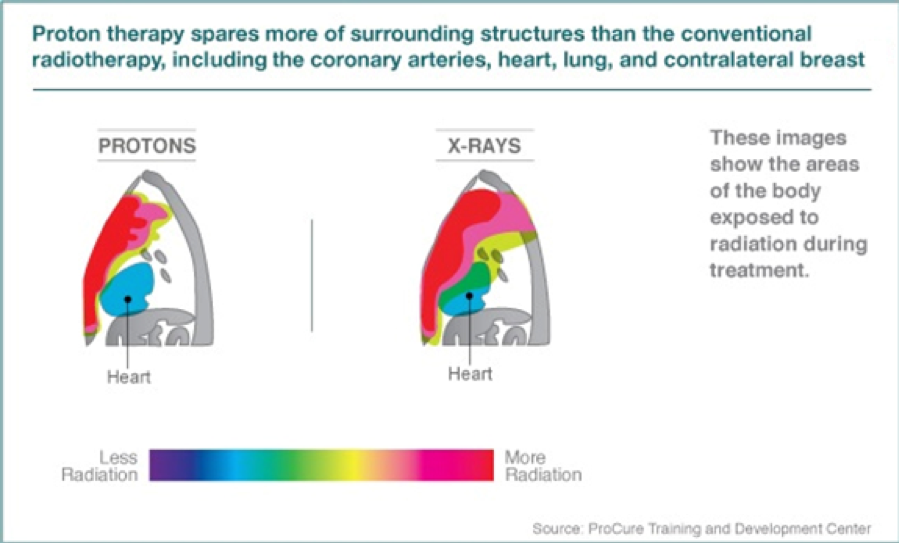Top Women’s and Men’s Cancer Treatment Developments
From breast cancer to prostate cancer, the state of oncology care and how it will evolve.

Click to expand

Although there isn’t a cure for cancer yet, clinical researchers are making great strides in treating this disease-which can attack any area of the body. Here’s a look at some top treatment developments for cancers that plague men and women specifically, along with a new treatment for prostate cancer.
Breast cancer
Novel treatments that limit radiation exposure are now being used to treat breast cancer. Stage 0 breast cancer, the earliest form of breast cancer that can be detected, is called ductal carcinoma in situ because it hasn’t yet found a way to leave the ducts in the breast and become invasive. Approximately 50,000 women are diagnosed with this type of cancer annually.
Roshni Rao, MD, FACS, chief of breast surgery, New York Presbyterian/Columbia University Medical Center, New York, New York, is currently enrolling patients in a study for intra-operative radiation after lumpectomy for these patients. The procedure involves removing cancer surgically with a lumpectomy, and then targeting a single high dose of radiation to the affected area. After closing the incision, the patient is finished with their cancer treatment.
Related article: Eight Predictions for Cancer Care in 10 Years
“Patients get the benefit of having everything done at one time, and minimizing the side effects from radiation of the entire breast,” she says. In comparison, patients who undergo traditional radiation must have treatments daily for three to six weeks that involve the entire breast.
The survival from stage 0 breast cancer is close to 99% with traditional radiation. However, recurrence can be as high as 20% if the tumor is removed with surgery. With targeted intraoperative radiation, early results show recurrence rates less than 5%.
Proton therapy for breast cancer
Proton therapy is an advanced form of radiation treatment that reduces radiation exposure to normal, healthy organs. Although conventional radiation treatment uses photons (traditional x-ray radiation), proton therapy uses protons-positively charged sub-atomic particles.
The main difference between these two treatments is their delivery, says Henry K. Tsai, MD, radiation oncologist, ProCure Proton Therapy Center, an outpatient facility in Somerset, New Jersey. Protons deliver their radiation at exact depths to precisely target tumors, whereas standard X-ray radiation releases radiation from the moment it penetrates the skin to the other side of the tumor and exits the body. With proton therapy, most radiation is deposited exactly at the tumor site and stops, thereby reducing radiation exposure to surrounding normal, healthy tissue and organs.
Proton therapy is particularly beneficial in treating left-sided breast cancer because of the target’s proximity to the heart and lungs. Studies have shown that patients with left-sided breast cancer may be more likely than patients with right-sided breast cancer to develop heart disease or other complications after receiving traditional radiation treatments.
Because protons deposit their energy directly into the tumor and not the tissue behind it, patients have less risk of unnecessary radiation exposure to the heart, lungs, and healthy tissues. “Less radiation to these areas may lower the risk of developing heart disease, lung disease, and secondary tumors decades after radiation treatment,” Tsai says.
According to the American Cancer Society, the risk of developing a solid tumor after radiation treatment increases as the exposure to radiation increases. These secondary cancers tend to develop in or near the area that was treated with radiation. “The breast is one region that’s more susceptible to developing cancer after radiation, so doctors should pay close attention to the amount of radiation a patient receives during treatment,” Tsai says. A study in the International Journal of Radiation Oncology found that proton therapy reduces the risk of a patient developing a second tumor by nearly half as compared with conventional radiation photon therapy.
Cervical cancer
For women with advanced cervical cancer, the FDA approved pembrolizumab, a type of immunotherapy for treatment after chemotherapy has stopped working, in June 2018. It is limited to women with tumors that have a marker- PD-L1-indicating an increased chance it will help. About 35% of women with advanced cervical cancer are eligible for this treatment, says Don S. Dizon, MD, FACP, FASCO, professor of medicine, Brown University; director of women’s cancers, Lifespan Cancer Institute; and director of medical oncology at Rhode Island Hospital; all located in Providence, Rhode Island.
Although the immune system typically fights foreign agents like bacteria, for some reason it doesn’t destroy cancer cells. One of the ways that cancer cells escape the body’s immune system is through immune checkpoints, which are literally breaks against the immune system that recognize and destroy cancer cells, says Dizon, who is also the section editor for Gynecologic Oncology for UpToDate from Wolters Kluwer. Pembrolizumab, a checkpoint inhibitor, blocks these breaks and allows the immune system to kill cancer cells.
Related article: 14 Ways to Make Cancer Patients More Comfortable
Data from a trial of 98 women who had progressive cervical cancer after chemotherapy presented at the 2018 American Society of Clinical Oncology meeting showed an overall response rate of 12% with pembrolizumab. This increased 15% if women had PD-L1 positive cancer. Overall, one in four women’s cancer didn’t progress. “While these results were encouraging, it points out how much work we have yet to do to help women living with advanced or metastatic cervical cancer,” Dizon says.
Some good news regarding preventing cervical cancer is that the Gardasil 9 HPV vaccine, which was FDA approved back in June 2006 for men and women up to age 26, is very effective in reducing disease associated with the human papillomavirus in boys and girls. It protects from pre-cancers associated with HPV such as cervical cancer. In October 2018, the FDA expanded the approved use of the vaccine to men and women ages 27 to 45.
Ovarian cancer
The initial treatment recommended for most women with ovarian cancer is surgery to remove all visible disease, followed by chemotherapy and radiation. Recent studies have shown that completely removing all visible cancer is associated with improvements in patient survival.
On Target Laboratories, in West Lafayette, Indiana, is developing a tumor-targeted molecule (OTL38) which allows a surgeon, with the use of a near-infrared camera, to see in real time hard-to-detect cancerous tissue that would otherwise go undiscovered during surgery. “By illuminating cancers, surgeons are better equipped to identify and remove more visible disease for more patients,” says Martin Low, MBA, chief executive officer, On Target Laboratories. “Furthermore, OTL38 is simply administered via intravenous injection (IV) during the pre-operative phase of the procedure. If the FDA approves it, it will be the first and only intraoperative ovarian cancer-targeted imaging molecule in the United States.”
OTL38 is a molecule that highlights cancerous lesions for surgeons. It works by linking a tumor-targeting molecule with a fluorescent dye. This molecule selectively binds and is taken into cancer cells, illuminating them in contrast to the surrounding tissue. This enables surgeons to clearly identify and distinguish cancer from healthy tissue. “Because OTL38 functions at a cellular level, even extremely small cancerous lesions may be identified under near-infrared light,” Low says. “Furthermore, the near-infrared characteristics may also enable surgeons to detect cancerous tissue obscured below the surface of healthy tissue.”
Clinical studies exploring the benefits of OTL38 are ongoing. Results from an early development program were very promising and indicate that OTL38 contributes to more removal of cancer tissue during surgery that was not identified visually or tactilely. The phase 1 study demonstrated that OTL38 enabled surgeons to resect an additional 29% of malignant lesions. On Target Laboratories is currently confirming these results in a phase 3 clinical study.
Prostate cancer
In 2018, personalized medicine took on a new meaning in the treatment of prostate cancer patients. The approach includes performing genetic testing on men with prostate cancer to look for genetic abnormalities. “We look for something they inherited, known as a germline defect, or something they acquired, known as a somatic defect,” says Nancy Dawson, MD, professor of medicine and oncology, and director of the Genitourinary Medical Oncology Program, Georgetown Lombardi Comprehensive Cancer Center, Washington, D.C., who notes that several novel therapies show great promise for treating prostate cancer. “We look for a genetic abnormality that we can target.” Having a genetic abnormality called microsatellite instability, seen in 3% to 5% of men with prostate cancer, can predict which new immunotherapies may be effective. It can help approximately 50% of men with the abnormality.
Also in 2018, two hormonal drugs-enzalutamide and apalutamide-were approved to treat non-metastatic, castration resistant prostate cancer. They delay the time it takes for prostate cancer to spread to other areas of the body. A third drug called darolutamide appears to be just as effective with much less toxicity, however it is not yet FDA approved but is on the fast track for approval. All three are oral drugs that block androgens-hormones that play a role in male traits and reproductive activity. “Compared to a placebo, patients using these three drugs had a longer timeframe of approximately two years before they developed metastatic cancer that spread to the bones and other organs,” Dawson says.
Finally, anti-prostate-specific membrane antigen (PSMA) therapy, which is currently in clinical trials, shows great promise. Most prostate cancers produce prostate-specific antigens (PSA) and PSMAs. The treatment works intravenously, by using an anti-PSMA antibody that allows physicians to target anything in the body that makes PSMA. The antibody is delivered with small doses of radiation to wherever cancer is located. Although it doesn’t cure prostate cancer, patients are seeing positive effects from it such as decreasing the PSA, making the cancer shrink, and making pain improve or resolve.
Pancreatic cancer
G. Paul Wright, MD, surgical oncologist, Spectrum Health, Grand Rapids, Michigan, recently began a clinical trial that uses hepatic artery infusion chemotherapy in addition to systemic chemotherapy to treat pancreatic cancer to the liver.
To understand how the treatment works, it’s important to know that the liver receives a dual blood supply. Most of the blood flow comes from a vein (portal vein) and a smaller amount from an artery (hepatic artery). Metastatic tumors to the liver, however, receive most of their blood supply from the hepatic artery. “Hepatic artery infusion chemotherapy leverages this fact by delivering high-dose chemotherapy directly into the artery via a surgically placed pump,” Wright says. The pump is implanted under the skin of the abdominal wall and attached to a catheter that delivers the drug directly into the hepatic artery. The delivered drug has special properties that allow it to stay within the liver so there are very few, if any, side effects to the rest of the body. It can hurt the liver, however, as can any standard chemotherapy.
Related article: The Alternative Cancer Treatments Health Execs Are Talking About
The clinical trial is ongoing for patients with metastatic pancreatic cancer and is the first of its kind in this patient population. “We have seen excellent responses in other tumor types (with this treatment) such as colon cancer spread to the liver; a partial response was seen in over 70% of patients,” Wright says. “The success in treating metastatic colon cancer to the liver came when systemic chemotherapy improved and could be combined with liver-directed therapies like the hepatic artery pump. I have seen a similar trend in recent years for pancreatic cancer, where systemic chemotherapy has become more effective.”
Despite these improvements, the median survival for people with metastatic pancreatic cancer remains less than one year. “We have a long way to go toward improving survival, but are hoping that this new treatment paradigm can help move the needle in a positive direction,” Wright says.
Karen Appold is a medical writer in Lehigh Valley, Pennsylvania.

Prevention Could Cut Global Cancer Deaths in Half
June 30th 2025According to the latest edition of The Cancer Atlas, lower-income nations are experiencing a rise in lung, colorectal and breast cancer incidence due to increasing adoption of behaviors associated with economic development—such as tobacco use, poor nutrition and physical inactivity.
Read More
Attacking PRPS Enzymes Offers Hope for Treating Fast-Growing Myc-Driven Lymphomas
June 10th 2025Researchers found that altering key enzymes involved in redox balance could disrupt the metabolism of Myc-driven lymphomas, which offers a potential new strategy to treat aggressive cancers.
Read More
Using the 'Pathway' Approach to Shorten the Time Between Cancer Diagnosis and Treatment
November 16th 2022In this episode of Tuning In to the C-Suite, Briana Contreras, editor with Managed Healthcare Executive spoke with Dr. Yuri Fesko, oncologist and vice president of Medical Affairs at Quest Diagnostics. In the conversation, Dr. Fesko addressed the ongoing issue of long gaps of times between receiving a diagnosis for a type of cancer and finally getting the treatment for it. Dr. Fesko shared the benefits a number of sectors receive when treating patients sooner and the steps to get there.
Listen
The First Financial Toxicity Tumor Board Reports Success in Individual Patient Savings
May 14th 2025Financial toxicity can affect patient outcomes and quality of life. For example, a patient may forgo treatment or medications to save money, or they may incur high medical debt or go into bankruptcy to pay for medical care.
Read More
Survey Reveals Cancer Doctors Struggle to Keep Up as Treatments Advance Quickly
May 11th 2025A new survey by Johnson & Johnson revealed that oncologists are overwhelmed by the rapid pace of innovation in cancer care, with many calling for better tools, education and collaboration to help integrate new treatments and technologies into everyday practice.
Read More